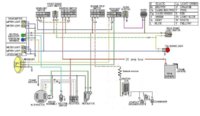Shifty2932
XS650 Enthusiast
Hello,
I know there are tons of wiring diagrams on this site, but I have found none really specific to what I am running. The PO who wired the bike made a mess of things and almost impossible to follow. I have recently finished reassembling the bike and over the weekend wired the bike from trying to follow the rat nest wiring job by the PO. Right now I have no spark and my battery keeps draining to nothing. Can anyone help me with a wiring diagram of what I am running?
I am running points, with a single input dual output coil and a ballist resistor. I have made my own 3 phase rectifier and also use the automotive VR-115 regulator. I am using a battery for power, keyed ignition and it's kick start only. The only things left that it am running is a single beam headlight, tail light with a brake switch. I feel that I have the wires connected right but it obviously is not working. Also which wires connect to which terminal lugs on the key ignition? I must not have labeled thingsvery well when I took it all a part and now feel like a dumbass




Any help would be appreciated so I can get to riding.
I know there are tons of wiring diagrams on this site, but I have found none really specific to what I am running. The PO who wired the bike made a mess of things and almost impossible to follow. I have recently finished reassembling the bike and over the weekend wired the bike from trying to follow the rat nest wiring job by the PO. Right now I have no spark and my battery keeps draining to nothing. Can anyone help me with a wiring diagram of what I am running?
I am running points, with a single input dual output coil and a ballist resistor. I have made my own 3 phase rectifier and also use the automotive VR-115 regulator. I am using a battery for power, keyed ignition and it's kick start only. The only things left that it am running is a single beam headlight, tail light with a brake switch. I feel that I have the wires connected right but it obviously is not working. Also which wires connect to which terminal lugs on the key ignition? I must not have labeled thingsvery well when I took it all a part and now feel like a dumbass





Any help would be appreciated so I can get to riding.



 Still no spark
Still no spark